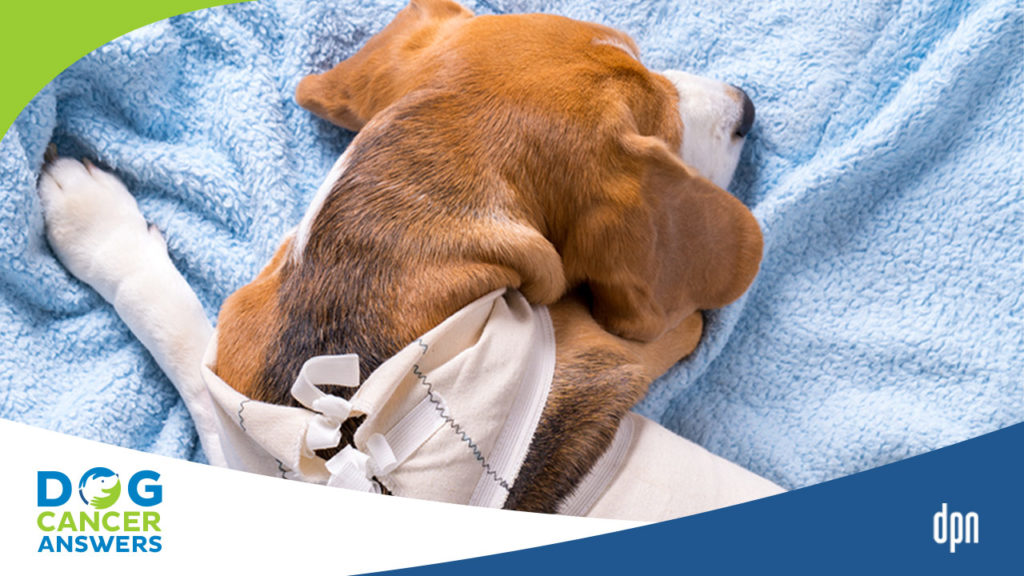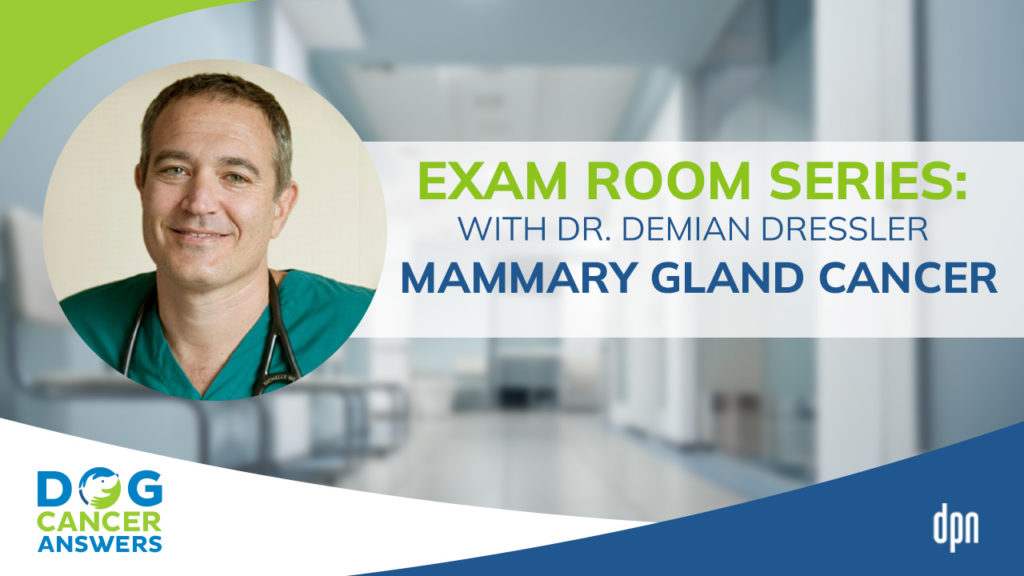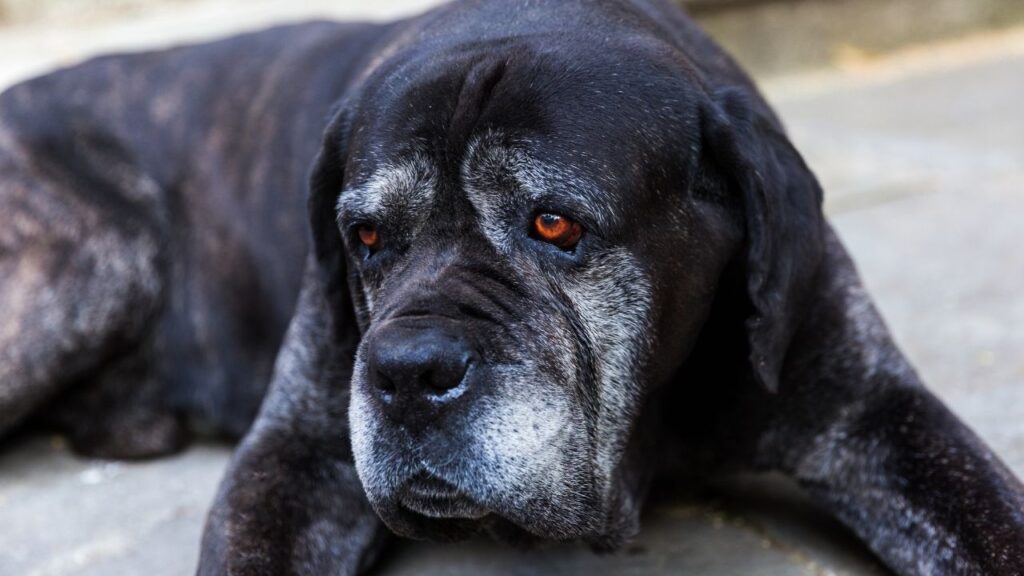Mammary tumors in dogs are the equivalent of breast cancer in humans, but unlike our breast cancer, they are not as aggressive as other cancers. Mammary gland adenocarcinoma in dogs generally responds well to treatment, and many less aggressive mammary tumors may be cured by surgery alone.
Key Takeaways
- Most dogs can survive a mammary gland tumor if they are caught and treated early. If the tumor can be removed entirely, many dogs can have a normal life span.
- About half of the mammary tumors in dogs are benign, and half are malignant (cancerous).
- Mammary tumors in dogs usually look like small firm nodules next to the nipples or softer diffuse masses you can feel in and around the mammary tissue.
- Mammary tumors are more common in older dogs, female dogs that have not been spayed, female dogs that were spayed later in life, and overweight dogs.
- There is no known way to “shrink” a confirmed mammary gland tumor, but surgery can remove them. Follow-up treatment is usually not necessary.
- Most dogs with mammary gland tumors do not have other signs of illness. However, after a mammary tumor grows, it may become inflamed and painful, and may spread to other parts of the body.
- Mammary gland tumors tend to grow under the influence of female hormones. Female dogs never spayed or spayed later in life are more likely to have mammary gland cancer.
Breast Cancer Is the Same as Mammary Tumors in Dogs
The mammary glands are located along the belly and chest in dogs, and they serve the same purpose in dogs as they do in humans. They contain connective tissue, fat, and glands that can make enough milk to nurse an entire litter of puppies at once.
Mammary tumors, which is what we call breast cancer in dogs, can occur in any of the many types of cells that make up the mammary glands.
Malignant and Benign Mammary Tumors in Dogs
While about half of mammary tumors in dogs are benign, the other 50% of mammary tumors in dogs are malignant, meaning cancerous and likely to spread to other parts of the body.
Types of malignant mammary tumors include:
- Adenocarcinoma which arises in the epithelial cells lining the mammary glands.
- Cystadenocarcinomas which arise from epithelial cells within the milk-producing structures of the mammary glands.
- Mixed tumors which arise from both epithelial and connective tissues.
- Inflammatory mammary carcinoma (IMC), which is rare but more aggressive and has a poorer prognosis.
Lipomas are another mammary tumor type that can occur. These benign tumors arise from the fat in the mammary area.
Early Stage Mammary Tumors In Dogs
Dogs with mammary tumors usually do not act sick, especially in the early stages. Many mammary tumors are found at home by the owner or in the office during a physical exam by a veterinarian.
Mammary tumors are typically slow-growing. However, if left untreated, malignant mammary tumors can spread to regional lymph nodes and to internal organs – usually the lungs. Metastasis can also occur in the liver, bone, and other bodily organs.1
Once metastasis has set in, your dog may start to act sick, and the symptoms will depend upon which body parts are affected.
Dr. Demian Dressler offers an overview of mammary tumors in dogs in this Exam Room episode of DOG CANCER ANSWERS.
Stats and Facts About Mammary Tumors in Dogs
- Mammary tumors are the most diagnosed abnormal growth in female dogs, accounting for nearly 50%.1
- Mammary tumors are extremely rare in male dogs.
- The earlier in her lifetime a female dog is spayed, the smaller the chance she will develop mammary cancer. 2,3
- Female dogs spayed before their first heat cycle have only a 0.5% risk of developing mammary tumors.
- When spayed between the first and second heat cycles the risk increases to 8%.
- After the second heat cycle, the risk increases to 26%.
- Adenocarcinoma, simple carcinoma, and complex carcinomas are the most common types of mammary carcinomas diagnosed. 2
- It is common to find more than one type of mammary carcinoma present at the time of diagnosis. 2
- It is also common to find some benign and some malignant mammary tumors in dogs with multiple mammary tumors.2
What Causes Mammary Tumors in Dogs
Several factors are thought to play a role in causing mammary gland carcinomas.
The presence of female sex hormones – hormones normally produced in the body of an intact female dog – is thought to be one of the main causes of mammary tumors. This is why female dogs who were not spayed – or were spayed later in life – have a higher chance of developing mammary gland carcinoma.
Genetic mutations have also been implicated as a cause of mammary tumors. One study found BRCA1 and BRCA2 to be the only mutations significantly associated with the development of mammary carcinomas, but the mechanism remains unknown.2
P53 and c-erb-2(HER-1/neu) are specific genes related to cancer expression, especially in human cancer. These genes are also suspected of playing a role in mammary cancer in dogs, but to date, the specific mutation has not been identified.3
Risk Factors for Developing Mammary Tumors
Any breed of dog can develop mammary gland carcinoma. Some breeds that are more likely to develop mammary tumors include:
- Spaniel breeds
- German Shepherds
- Toy and Miniature Poodles
- Pointer breeds
- Dachshunds
- Maltese
Longer exposure to female sex hormones increases the risk of developing mammary tumors, which is probably why they are most common in intact females and females spayed after their first or second heat cycle.
Body condition and diet have also been shown to play a role in the development of mammary gland carcinoma in dogs:
- Dogs that become obese at a young age (between 9-12 months old) have an increased risk of mammary tumors later in life.3,4
- A 2020 study found that dogs fed a homemade diet, especially with a lot of red meat, were at increased risk due to being more likely to be overweight.5
- Dogs with higher body condition scores (i.e., overweight or obese dogs) had a higher prevalence of more aggressive mammary gland carcinomas.5
Symptoms You Will See in Your Dog
Most dogs with mammary gland tumors behave normally and show no signs of illness.
Tumors are usually first noticed by the guardian when petting the dog, or by a veterinarian during a routine physical exam.
- If found early, mammary tumors are usually first noticed as small, firm masses right beside a nipple, or feel like multiple, diffuse masses in the soft mammary tissues.
- If found after they have been growing for some time, the mammary glands may be warm, swollen, and/or red. Your dog may lick the area or be painful to the touch.
Diagnosing Mammary Tumors in Dogs
If your veterinarian suspects a mammary tumor, they may recommend starting with a fine needle aspirate (FNA). An FNA is a type of biopsy that uses a small needle to collect cells from the affected area. Those cells are then examined with a microscope. The types of cells found in this sample will help inform whether or not the mass is a tumor, an infection, or inflammation.
If the mass is suspected to be a mammary tumor, your veterinarian may recommend some further testing. Some tests that may be recommended include:
- An FNA of lymph nodes in the area to check for lymph node involvement.
- Imaging (X-rays, CT scan, or ultrasound) of the chest and abdomen to look for any signs that cancer has spread to the lungs and/or other organs.
- Blood work and urinalysis are also recommended to look for any additional health issues. These tests may be normal in dogs with mammary tumors, but they will still be useful for planning surgery.
If there is a tumor present, surgery to remove the entire mass is recommended (except in some cases of inflammatory mammary carcinoma).
The mass should then be sent to the lab for histopathology. The laboratory report will say if it is malignant or benign, and if the surgical margins are clean. Clean margins mean the entire mass has been removed with a sufficiently sized border of healthy cells.
The information in the pathology report along with the initial imaging and bloodwork will provide a more accurate diagnosis and prognosis.
Staging and Prognosis for Mammary Tumors in Dogs
Veterinarians and veterinary oncologists use prognosis and staging to help guide treatment decisions.
- Staging is the process of determining how much cancer is in the body and if and where it has spread.
- The prognosis is a prediction of how a specific tumor type may behave and what the likely outcome may be.
Classification and Grading of Canine Mammary Tumors That Are Malignant
The higher the stage of a malignant mammary tumor, the worse the prognosis. These tumors are staged using the following scheme:
- Stage I – tumors are < 3 cm in diameter, have not metastasized, and there is no regional lymph node involvement.
- Stage II – tumors are 3-5 cm in diameter, have not metastasized, and there is no regional lymph node involvement.
- Stage III – tumors are > 5 cm in diameter, have not metastasized, and there is no regional lymph node involvement.
- Stage IV – tumors of any size that have not metastasized but do have regional lymph node involvement.
- Stage V – tumors of any size that have metastasized +/- have regional lymph node involvement.
In general, low-grade malignant mammary tumors can be cured by complete surgical removal, though some of these may recur and metastasize.
High-grade malignant mammary tumors are much more likely to recur, metastasize, and metastasize sooner.
The Prognosis for Canine Mammary Tumors
The prognosis for mammary carcinoma in dogs varies widely, based on specific tumor type.
Benign mammary tumors are usually cured by complete surgical removal.
The prognosis for patients with malignant mammary tumors is highly variable and depends on the stage and grade, with higher stages and grades having a poorer prognosis.3
Other factors can also worsen the prognosis:
- Older dogs
- Unspayed (intact) dogs
- Dogs with tumors that have estrogen or progesterone receptors present,3
- Dogs with invasive or ulcerated tumors.
Interestingly, having multiple tumors does NOT worsen the prognosis.
Mammary Tumors in Dogs Are Highly Treatable
Except for inflammatory mammary carcinoma, mammary tumors are one of the “better” cancers for a dog to get, because they are more treatable. Surgery alone is enough for many cases.
Even if a cure is not possible, the treatment focus is on improving and maintaining the quality of life while also hopefully extending the dog’s life beyond what would’ve happened if the cancer wasn’t treated.
Inflammatory Mammary Carcinoma: The Exception
Unfortunately, treatment options for inflammatory mammary carcinoma are limited. Surgery, chemotherapy, and radiation may be used for palliative care but are generally not effective for curing this cancer. There is more about the reasons why in the following sections.
Piroxicam, an NSAID, has been shown to improve quality of life and survival times for dogs with inflammatory mammary carcinoma.12 This is why Piroxicam or another NSAID may be considered as a first-line option for palliative care for this tumor type.
Surgery for Canine Mammary Tumors
Surgery is the first-line treatment for all mammary tumors (except inflammatory mammary carcinoma).
Your veterinarian or surgeon will aim for wide, 2-centimeter margins to ensure the entire tumor and all affected tissues are removed. Then the tumor(s) should be submitted to the lab for histopathology to determine the tumor type and assess the margins.
The good news is that half of malignant mammary tumors can be cured with surgery alone, especially in spayed dogs.
Dr. Brooke Britton helps a listener determine if his dog's mammary tumor surgery is being pushed off too far on this episode of DOG CANCER ANSWERS.
Spayed Dogs Are Likely to Get a Lumpectomy or Simple Mastectomy
For spayed dogs, a lumpectomy (removing only the individual mammary tumor) or simple mastectomy (removing the entire involved mammary gland) with complete margins can cure the dog.
Intact Dogs May Need a Radical Mastectomy
For intact dogs, a radical mastectomy may be considered. A radical mastectomy doesn’t just remove the one gland, but the entire chain of mammary glands on the affected side. The reason we want to remove the entire chain is because 58% of intact female dogs will develop more tumors on the same side.6
Intact Dogs May Need a Spay
Because mammary tumors are influenced by hormones, spaying at the time of surgery is also often recommended, though it won’t benefit all dogs.2 Spaying is most beneficial for those with Stage II, estrogen receptor-positive mammary tumors.7
Lymph nodes in the area may also be removed, depending on if they are enlarged and depending on their location.
Surgery for Inflammatory Mammary Carcinoma
In general, surgery is not recommended because this tumor type’s severe inflammation prevents the incision from healing well.3 However, your veterinarian may recommend surgery for palliative care, or to maintain quality of life.
Chemotherapy for Mammary Tumors in Dogs
Chemotherapy is not always needed for mammary tumors in dogs, but it may be most useful when tumors are still microscopic – before metastasis occurs. It is usually recommended for advanced stages with a high risk of metastasis.3
There are several potential chemotherapy protocols to treat mammary tumors in dogs, though it is not clear which is best so your oncologist will make their recommendations based on what they see in your dog’s specific case.
All of these protocols recommend surgery first:
- Cyclophosphamide following surgery has been shown to cause tumor regression and increased survival times with minimal adverse effects.8
- Doxorubicin or doxorubicin combined with cyclophosphamide has also been used with favorable results.9
- Combining 5-FU with cyclophosphamide been shown to significantly increase survival times compared to surgery only.3
- Metronomic therapy with cyclophosphamide and toceranib (a COX-2 inhibitor) has also shown promise as a potential protocol for treating dogs with mammary tumors.10
Radiation for Mammary Carcinomas in Dogs
If surgical removal is incomplete and there are dirty or incomplete margins, and additional surgery is not possible, radiation may be recommended as a follow-up treatment.
Radiation can also be used palliatively to help (but likely not cure) mammary tumors that cannot be surgically removed.
Immunotherapy for Mammary Carcinomas in Dogs
Immunotherapy is not yet commercially available for mammary tumors, but studies are underway.
A Vaccine for Mammary Tumors?
One study from Auburn University showed promising results for using autologous vaccines to evoke an anti-tumor response.11 Autologous vaccines take a sample of your dog’s tumor and make a vaccine specifically targeting that tumor. More studies are needed, but this may be a promising future treatment.
Diet for Dogs with Mammary Tumors
Some studies have linked a homemade diet and high red meat intake4 with an increased risk for mammary gland carcinoma.
A more recent study suggests the risk is more likely related to body weight, as dogs on a homemade diet are more likely to be overweight, and overweight dogs are more likely to develop mammary gland carcinoma.5
As with all cancers, a balanced, healthy diet is best for dogs with mammary cancer.
Supplements for Mammary Tumors
No specific oral supplements are currently recommended for mammary tumors. In most cases it is better to choose a few supplements that target your dog’s primary needs, rather than throwing a bunch of products at her. This will also help to keep costs down.
Always consult your veterinarian before adding a supplement to ensure that it is a good fit for your dog and won’t interfere with any of her medications or treatments.
Integrative Therapies
Acupuncture and/or acupressure may help manage the side effects of treatment and improve your dog’s quality of life.
A trained veterinarian should perform acupuncture. Acupuncture should not be used in dogs with suspected inflammatory mammary carcinoma.
A veterinarian trained in acupressure can teach you how to do it at home.
What the End Stages of Mammary Tumors in Dogs Look Like
Mammary tumors in dogs are very treatable, especially if detected early, and may not affect your dog’s lifespan. Half of mammary tumors are benign and cured with surgery alone. Even malignant mammary tumors generally have good outcomes with prompt surgery with wide margins. A normal lifespan is often achievable.
Inflammatory mammary carcinoma, which grows rapidly and metastasizes quickly, is the exception to this rule. If your dog has this cancer type, or another mammary tumor that is malignant and has metastasized, death is usually from complications of metastasis to the lungs or other organs.
If at any point you are concerned about your dog suffering, open up a conversation with your veterinarian about hospice care. It doesn’t mean you are “giving up” on your dog to start palliative care.
Prevention Strategies for Mammary Tumors
The most important prevention strategy for mammary carcinoma is spaying your dog at a young age, although early spaying can increase the risk for more aggressive cancers in some dogs, so timing should be carefully considered with your veterinarian.
Keeping your dog at an appropriate weight throughout life also reduces the risk of developing mammary tumors.
Finally, because 50% of masses found on female dogs are mammary gland tumors, and they are usually found through petting, a thorough monthly home exam can help you detect these tumors early, get them removed promptly, and hopefully, have a good outcome.
- Gray M, Meehan J, Martínez-Pérez C, et al. Naturally-occurring canine mammary tumors as a translational model for human breast cancer. Frontiers in Oncology. 2020;10. doi:10.3389/fonc.2020.00617
- Kaszak I, Ruszczak A, Kanafa S, Kacprzak K, Król M, Jurka P. Current biomarkers of canine mammary tumors. Acta Veterinaria Scandinavica. 2018;60(1). doi:10.1186/s13028-018-0417-1
- Dressler D, Ettinger S. Chapter 31: Mammary Tumors. In: The Dog Cancer Survival Guide: Full Spectrum Treatments to Optimize Your Dog’s Life Quality and Longevity. Maui, HI: Maui Media, LLC; 2011:320-336.
- Alenza DP, Rutteman GR, Peña L, Beynen AC, Cuesta P. Relation between habitual diet and canine mammary tumors in a case-control study. Journal of Veterinary Internal Medicine. 1998;12(3):132-139. doi:10.1111/j.1939-1676.1998.tb02108.x
- Tesi M, Millanta F, Poli A, et al. Role of body condition score and adiponectin expression in the progression of canine mammary carcinomas. Veterinary Medicine and Science. 2020;6(3):265-271. doi:10.1002/vms3.238
- Stratman N, Failing K, Richter A, Wehrend A. Mammary tumor recurrence in bitches after regional mastectomy. Veterinary Surgery. 2008;37(1):82-86. doi:10.1111/j.1532-950x.2007.00351.x
- Kristiansen VM, Peña L, Díez Córdova L, et al. Effect of ovariohysterectomy at the time of tumor removal in dogs with mammary carcinomas: A randomized controlled trial. Journal of Veterinary Internal Medicine. 2015;30(1):230-241. doi:10.1111/jvim.13812
- Suryawanshi RV. Assessment of efficacy and toxicity of cyclophosphamide chemotherapy in canines with malignant mammary tumor: A retrospective study. Veterinary Medicine International. 2021;2021:1-8. doi:10.1155/2021/5520603
- Kuruoglu FE, Ozyigit MO, Nak D, et al. Efficacy and toxicity of doxorubicin and cyclophosphamide for the neoadjuvant treatment of locally advanced stage canine mammary tumors. Kafkas Univ Vet Fak Derg, 2020; 26(6):729-734. doi: 10.9775/kvfd.2020.24112
- Alonso‐Miguel D, Valdivia G, García‐San José P, et al. Clinical outcome of dogs diagnosed with canine inflammatory mammary cancer treated with metronomic cyclophosphamide, a cyclooxygenase‐2 inhibitor and Toceranib Phosphate. Veterinary and Comparative Oncology. 2021;20(1):179-188. doi:10.1111/vco.12760
- Martinez Romero, Esther Gisela. “Mammaglobin-A: A Potential Immunotherapy Target for Canine Mammary Cancer.” 2020.
- de M Souza CH, Toledo-Piza E, Amorin R, Barboza A, Tobias KM. Inflammatory mammary carcinoma in 12 dogs: clinical features, cyclooxygenase-2 expression, and response to piroxicam treatment. Can Vet J. 2009;50(5):506-510.
Topics
Did You Find This Helpful? Share It with Your Pack!
Use the buttons to share what you learned on social media, download a PDF, print this out, or email it to your veterinarian.







